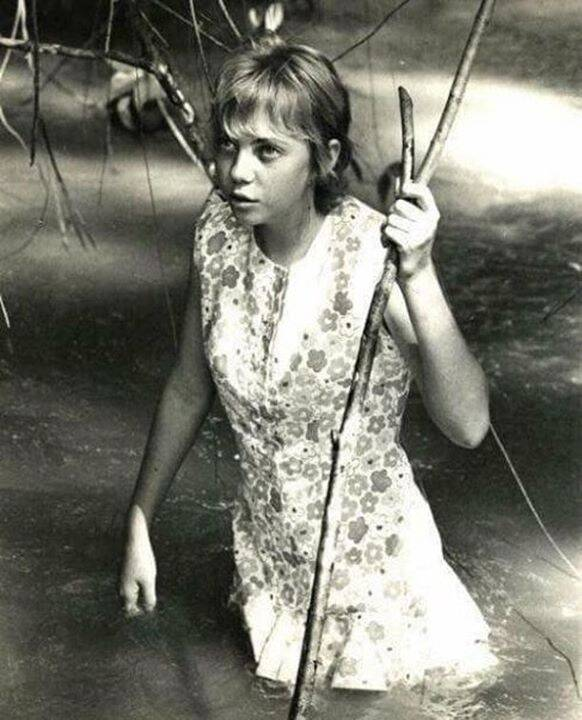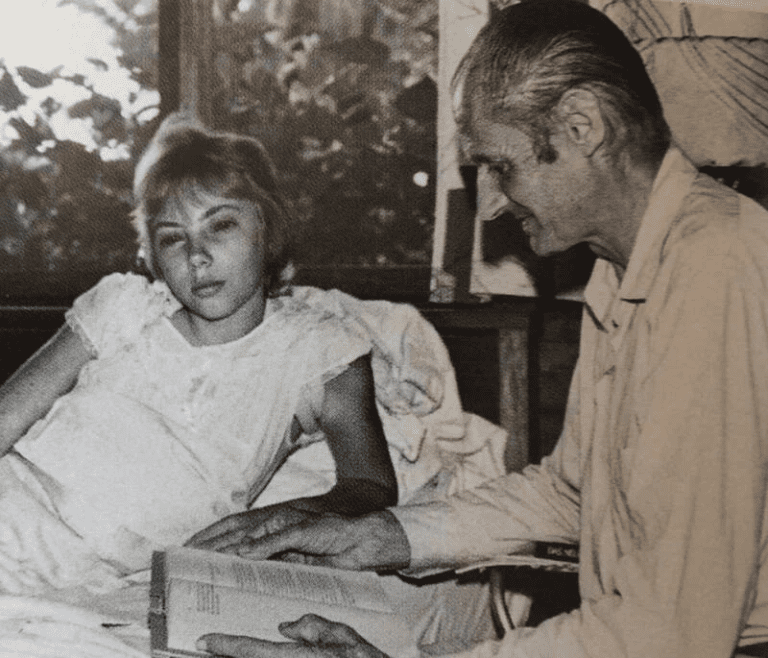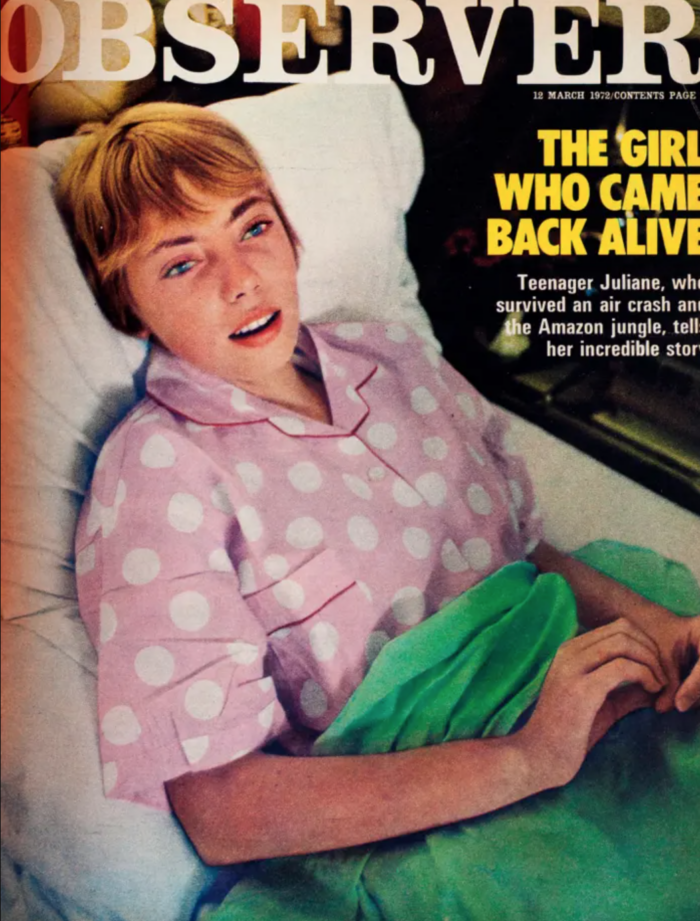On December 24, 1971, 17-year-old Juliane Koepcke boarded LANSA Flight 508 with her mother, thinking they were heading to the Amazon for a quiet holiday. She had just graduated high school and was planning to follow in her parents’ footsteps as zoologists. The flight from Lima to Pucallpa, Peru, should have taken less than an hour. But fate had something else in store.
Just 25 minutes into the journey, the plane was struck by lightning. The fuselage broke apart mid-air. Still buckled into her seat, Juliane was ejected from the aircraft—freefalling nearly two miles into the heart of the Peruvian jungle. Against all odds, she lived.

Born With Nature in Her Blood
Juliane wasn’t like most teenage girls. She had grown up surrounded by wilderness and wildlife. Her parents, German biologists Hans-Wilhelm Koepcke and Maria Koepcke, had created a research station called Panguana deep in the rainforest. It became Juliane’s second home.
While other kids learned geometry and French verbs, Juliane was learning how to recognize poisonous plants, follow animal trails, and find water in the jungle. Her survival instincts were rooted in real-life experience—something she would soon rely on in the most extreme circumstances imaginable.
Video: How Juliane Koepcke Survived A Plane Crash And 11 Days Alone In The Amazon
A Violent Storm and a Fall Through the Sky
As Flight 508 flew over the jungle, it entered a violent thunderstorm. Passengers panicked. The plane rocked violently, and the overhead compartments exploded open. Then came the blinding flash—a lightning bolt struck the engine.
Within seconds, the plane began to disintegrate. Juliane’s mother turned to her and said, “This is it.” And then it was chaos.
Juliane was suddenly outside the plane, seatbelt still strapped, plummeting through the sky. At over 10,000 feet, surrounded by debris and deafening silence, she lost consciousness.
She woke up hours later—alone, bruised, and partially buried in the jungle.
Alone in the Amazon With Only Her Wits

Juliane’s injuries were serious: a broken collarbone, deep cuts on her leg, a swollen eye, and a concussion. She called out for her mother but got no response. She was completely alone.
Instead of panicking, she did what her jungle upbringing had taught her—she got up and started moving. Within hours, she found a small stream. She remembered her father’s advice: “Follow water. It always leads to people.”
So that’s what she did. For eleven days, she followed the stream. No food, no shelter, just a strong will to survive and the skills she learned growing up.
A Journey Fueled by Courage and Candy

Juliane had only one real source of nourishment: a small bag of candy she found among the wreckage. That, and the water from the stream, kept her going.
She floated down the river, dodged crocodiles, and endured bug bites and infection. At one point, maggots infested a wound on her arm. Her strength was failing, but she kept moving, day after day, step after painful step.
On the fourth day, she saw something that stopped her cold—three passengers still strapped to their seats, driven headfirst into the jungle floor. It was a chilling reminder of how close she had come to death.
An Eerie Discovery and a Glimmer of Hope
Video: Juliane Koepcke: The Teen Who Survived a Plane Crash Miracle
Juliane knew helicopters were searching for the wreckage, but the dense jungle canopy made it impossible for anyone to see her. Every day she hoped to hear voices or see people. Nothing.
Finally, on the ninth day, she found a small logging shelter—abandoned, but proof she wasn’t far from civilization. Exhausted and barely able to stand, she waited.
The next day, three loggers arrived. At first, they thought she was a forest spirit—her hair matted, skin pale, and eyes glassy. But when she spoke Spanish and explained who she was, they realized she was human. A miracle in the flesh.
They cared for her wounds, gave her food, and paddled her downriver to safety.
The Sole Survivor of LANSA Flight 508
When Juliane finally reunited with her father, she learned the devastating truth. Out of 92 people onboard, she was the only survivor. Her mother had survived the fall too but tragically d*ed from her injuries days later.
Juliane’s survival wasn’t just about chance. It was about instinct, knowledge, and an unbreakable spirit. She walked through the jungle battered, starved, and alone—but never gave up.
Life After the Fall

Juliane didn’t come out of the jungle unchanged. She battled survivor’s guilt, flashbacks, and the crushing loss of her mother. She avoided flying for years. The media hounded her for details she wasn’t ready to share.
Eventually, she moved to Germany, earned a PhD in biology, and returned to Peru for field research. She married and took the name Dr. Juliane Diller. Her life moved forward, but the trauma always stayed with her—quietly shaping who she became.
Revisiting the Past
In 1998, Juliane returned to the crash site for Werner Herzog’s documentary Wings of Hope. Herzog had narrowly missed being on that same flight. Together, they traced her survival route. Sitting once more in seat 19F—the very row from which she had fallen—Juliane faced the haunting memories with astonishing calm.
Taking Control of Her Own Story

Years later, she wrote a memoir titled When I Fell from the Sky. In it, she detailed not only her fall and survival but her inner journey—the loneliness, the grief, and the quiet strength it took to reclaim her life.
She didn’t glamorize the pain. She didn’t pretend to have all the answers. She just told the truth. And in doing so, she gave hope to people facing their own impossible battles.
Conclusion
Juliane Koepcke’s story is more than a tale of survival. It’s a testament to human resilience and the power of preparation. She didn’t have gear, support, or food. What she had was grit. Instinct. And the ability to stay calm in the face of horror.
She fell 10,000 feet and lived to tell the world. But perhaps her greatest strength was not in the fall, or even in the walk through the jungle. It was in how she chose to live afterward—with grace, courage, and an unshakable will to honor the life she was given.
In a world full of chaos, Juliane Koepcke reminds us that even in the darkest places, the human spirit can rise.


